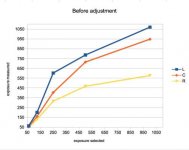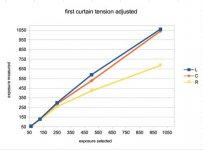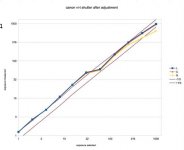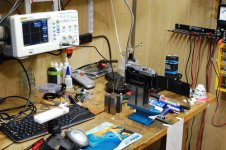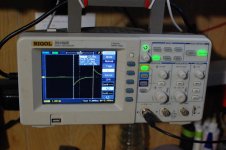bjel
Member
Hi all,
While this topic has been addressed many times in the forums, I have not found this particular variation on the question, so I appeal to the collective wisdom.
I have a Canon vi-t and my DIY shutter tester revealed a large variation in shutter speed across the frame. Viewed from the back of the camera the curtains travel right to left and I was getting underexposure on the left side of the frame and also a very non-linear shutter speed progression.
I lack the confidence to do a complete stripdown of the camera so I lubricated the accessible bearings and gears and saw no marked improvement. Given that this is an older camera it seems to me unlikely that the 2nd curtain is running too fast, and more likely that the 1st curtain is running too slow. I tweaked the tension on the 1st curtain and got a great improvement in the exposure in the centre and left side of the frame. The right side is still overexposing, by more than half a stop at the highest speed. (see attached graphs) The data does not include speeds below 1/60 as I am concerned with curtain speed, not the slow speed escapement.
So I wonder what would be a reasonable next move. This could include just living with it, because I don't need 1/500 and 1/1000 very often anyways. I have only been measuring the exposure at three locations, so I do not know how wide the overexposed area on the right side is. I look forward to advice.
While this topic has been addressed many times in the forums, I have not found this particular variation on the question, so I appeal to the collective wisdom.
I have a Canon vi-t and my DIY shutter tester revealed a large variation in shutter speed across the frame. Viewed from the back of the camera the curtains travel right to left and I was getting underexposure on the left side of the frame and also a very non-linear shutter speed progression.
I lack the confidence to do a complete stripdown of the camera so I lubricated the accessible bearings and gears and saw no marked improvement. Given that this is an older camera it seems to me unlikely that the 2nd curtain is running too fast, and more likely that the 1st curtain is running too slow. I tweaked the tension on the 1st curtain and got a great improvement in the exposure in the centre and left side of the frame. The right side is still overexposing, by more than half a stop at the highest speed. (see attached graphs) The data does not include speeds below 1/60 as I am concerned with curtain speed, not the slow speed escapement.
So I wonder what would be a reasonable next move. This could include just living with it, because I don't need 1/500 and 1/1000 very often anyways. I have only been measuring the exposure at three locations, so I do not know how wide the overexposed area on the right side is. I look forward to advice.


